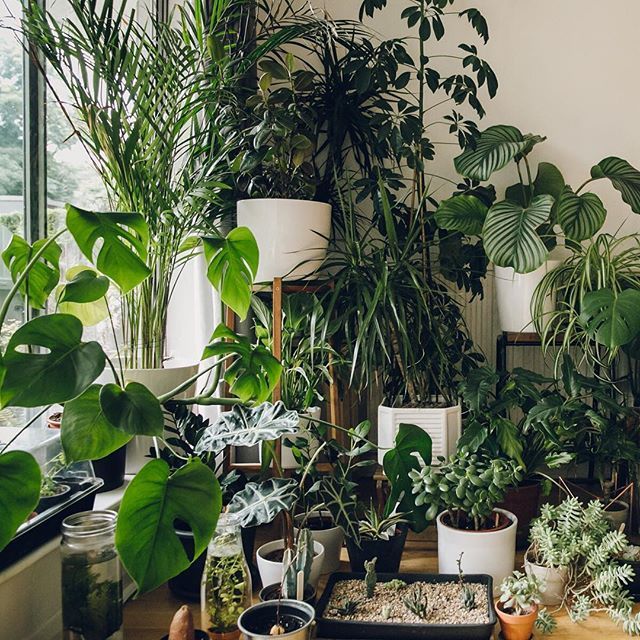Humidity for Health
- 2020-11-08
- By mkirk
- Posted in The Garden Buzz
By Paula Szilard, Colorado Master Gardener
Colorado is a challenging environment for the tropical plant enthusiast. Many people who grow tropical rainforest plants in Colorado’s dry climate have learned the lessons of humidity the hard way—a failure to thrive, wilting, decline, or sudden death by collapse.
The term relative humidity (RH) is very descriptive. It’s the amount of water that the air can hold at a specific temperature. In the winter months, non-humidified interiors without plants can have a relative humidity of as little as 10%. Unfortunately, most plants from the humid tropics thrive under much higher RH. So, lovers of tropical plants have to work hard at creating an optimal environment for their plants.

For health and adequate growth, plants try to maintain an equilibrium between the amount of water they lose through transpiration and the amount they take up. The hotter and sunnier the environment, the more most plants transpire. To some extent, plants can control this process by opening and closing the stomates or pores on the underside of the leaf blade. When the stomates are open, carbon dioxide can enter, but water is lost through transpiration. Wilting causes the stomates to close, reducing water loss, but also reduces carbon dioxide uptake, thus reducing photosynthesis and resulting in less vigorous growth. This may be a partial explanation for the less luxuriant growth of plants in environments with reduced humidity.
In areas where rainfall is high, humidity is also high. When it’s raining and the humidity is close to 100%, plants are in a state of equilibrium. They absorb as much water from the air as they transpire. As temperatures increase, the air can hold more water and if more water is actually present, this equilibrium is maintained. If more water is not present, as the temperature rises, the humidity drops and the plant is no longer in equilibrium. If it can absorb the required water from the soil through its root system quickly enough, the equilibrium is likewise maintained. If not, the plant wilts, even though there might be sufficient moisture in the soil. The plant roots just can’t absorb it quickly enough to replace the lost moisture.
In the normal situation, if the temperature keeps rising and there is no increase in atmospheric moisture, then the plant could wilt beyond recovery. Many of us have had this experience. In its native habitat, the plant is usually in a state of equilibrium with its environment. The root system has grown to collect sufficient moisture to replace what is lost through transpiration. It is in balance with the amount of foliage it has to support. If the root system is too small to support the leaves, the plant wilts. Adding moisture to the soil won’t help because the roots cannot take it up fast enough. This is why, when propagating plants under lights, you need to remove the plastic covering very gradually and you don’t want to remove the covering at all before the plant has developed a strong root system. It’s why, when propagating, you should cut off most of the leaves. It’s also why, when you keep watering a wilted plant with a poor root system or a plant that needs less water than you give it, eventually the roots rot away and the plant dies. Since adding water to the soil won’t help, you have to increase the humidity. As a quick emergency measure spraying the leaves with water can help. A longer term solution is a humidifier or just getting more plants. Houseplant books suggest grouping plants together and putting pebble trays under plants to increase humidity levels around plants. Unfortunately, when you have a sizeable collection, this becomes unworkable.

Nothing humidifies your interior environment like a lot of plants. Members of the Tropical Plant Society have heard this story before, but I repeat it here because it is such a valuable lesson. When my husband and I moved here from Hawaii 15 years ago, we were uncomfortable. We were used to a high humidity environment and we were having nosebleeds and problems with dry skin. My husband checked the humidifier attached to the furnace and determined that we needed a new one. We called the company that had installed the existing humidifier and had them install a new one.
At the same time, I started to fill the house with tropical plants, harvesting every ray of sunshine that entered our windows. I even had plants in our basement windows. Our humidity levels began to rise and we felt better. We were quite pleased with our new humidifier! When the time came to clean it, my husband discovered that the installer had never actually finished hooking it up. All that increased humidity resulted from transpiration of water from the plants and evaporation directly from soil. Later, when I was in Colorado Master Gardener training, I found confirmation of this phenomenon. I learned that approximately 90% of the water we pour on our plants is transpired or evaporated into the air. The moral of this story, of course, is that if you have enough plants, you don’t need a humidifier. They are better than a humidifier. Plus, humidifiers don’t clean your air, and plants do!
Author’s Note: I am grateful to Thomas J. Lemieux, Director of Plant Science Facilities at the University of Colorado in Boulder for reading the text and suggesting valuable changes, both for substance and clarity.
Horticulture Resources
- Garden Buzz Archives
- CSU Extension Resources
- Colorado Master Gardener Program
- Foothills to Plains Native Plant Master Program
- Native Bee Watch Community Science Program
- The Co-Hort Blog
- PlantTalk Colorado
- Soil Testing
- Plant Select
- Emerald Ash Borer
- Japanese Beetle
- Colorado State Forest Service
- Ask an Expert


